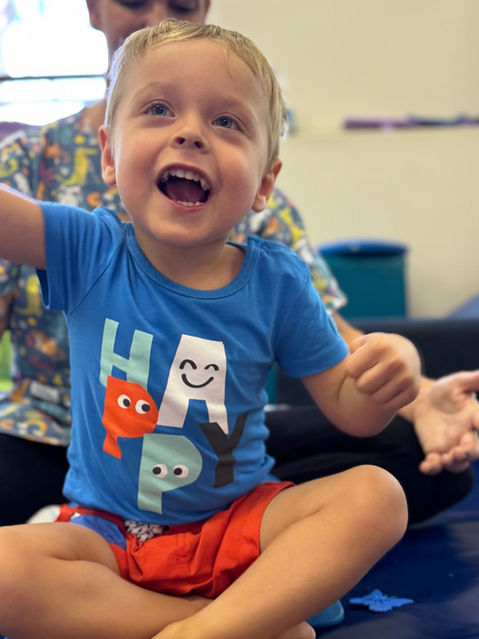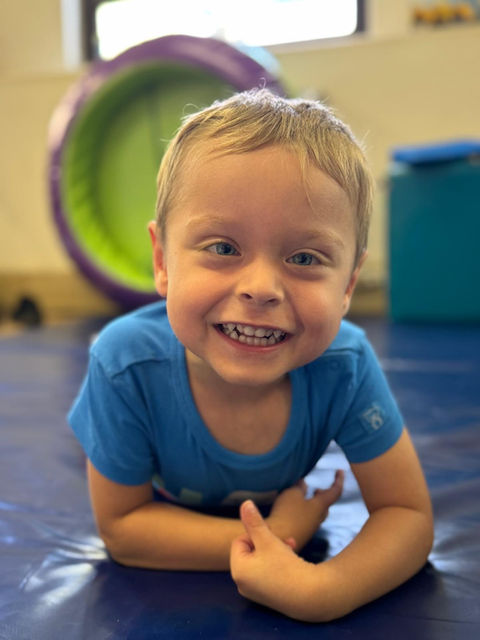Meet William
William is a positive, energetic little boy who loves building puzzles, playing with Lego, and spending time outdoors.
Despite his physical challenges, he has a great sense of humor and enjoys reading books and singing songs.
William's Story
William and his twin brother, Eli, had a complicated start even before they were born. During pregnancy, they were diagnosed with Twin-to-Twin Transfusion Syndrome (TTTS), a serious condition that affects identical twins who share a placenta. TTTS has a survival rate of approximately 60-70% after intervention, and we were faced with the terrifying prospect of losing both our boys. Thankfully, they underwent a life-saving laser procedure while still in the womb, giving them a fighting chance.
The boys were born prematurely at 29 weeks, and it was then that we discovered the next challenge: William had suffered a stage 2 brain bleed. This injury led to the suspicion and eventual diagnosis of cerebral palsy (CP) when he was 2 years old.

CP is a group of disorders that affect movement and muscle tone, and in William’s case, he was diagnosed with spastic diplegia with mild quadriplegia. This means that while his mental abilities are unaffected, his physical capabilities are significantly impacted.

William has been diagnosed with spastic diplegia with mild quadriplegia, a type of cerebral palsy that primarily affects the legs and, to a lesser extent, the arms.
This condition has made it difficult for William to walk, stand, or sit without assistance. Despite his intensive therapy regimen, the spasticity in his muscles remains a significant barrier to his mobility and independence.
We are raising funds for William to undergo Selective Dorsal Rhizotomy (SDR) surgery in October 2024 at St. Louis Children's Hospital in Missouri.
SDR is a procedure that reduces spasticity in the legs by cutting selective nerve roots in the spinal cord. This surgery offers William the best chance to improve his mobility and achieve greater independence.
Spasticity is a condition where certain muscles are continuously contracted, which can interfere with movement, speech, and gait. SDR aims to reduce this spasticity, primarily in the legs, thereby improving the patient’s mobility and overall quality of life.
For children like William, SDR surgery offers several significant benefits:
-
Reduced Spasticity: The primary benefit of SDR is the reduction in muscle spasticity, which can greatly improve comfort and ease of movement.
-
Improved Mobility: Many patients experience enhanced mobility, making it easier for them to walk, sit, and perform daily activities.
-
Enhanced Independence: With improved motor function, patients can achieve greater independence in their daily lives.
-
Better Quality of Life: The overall quality of life often improves as patients gain more control over their movements and experience less pain and discomfort.
Why We Need Your Help
SDR surgery involves the following steps:
-
Identification of Nerve Roots: The surgeon makes a small incision in the lower back to access the spinal cord. Using sophisticated equipment and techniques, the surgeon identifies the sensory nerve roots responsible for the spasticity.
-
Selective Cutting: The identified nerve roots are carefully tested and selectively cut. By severing only the problematic nerve fibers that are sending abnormal signals to the muscles, the surgery reduces the excessive muscle tone and spasticity.
-
Closure and Recovery: Once the necessary nerve roots have been cut, the incision is closed, and the patient begins the recovery process, which includes intensive physical therapy to maximize the benefits of the surgery.
Selective Dorsal Rhizotomy (SDR) surgery offers William the chance to reduce spasticity and improve his mobility and independence.
Expected Improvements:
-
Enhanced Mobility: Easier walking, standing, and better balance.
-
Increased Independence: Greater ability to perform daily tasks and boosted self-confidence.
-
Reduced Pain: Less muscle tightness and discomfort, leading to better sleep and comfort.
-
Long-Term Benefits: Continued progress with ongoing therapy, opening up new opportunities for growth.
Our hope is that SDR surgery will provide William with the tools he needs to overcome the physical challenges posed by cerebral palsy.
We are deeply grateful for your support and generosity, which bring us closer to making this life-changing procedure a reality for William.
Your contribution will not only help fund the surgery but also ensure that William receives the comprehensive care and therapy he needs to thrive.
Together, we can give William the chance to achieve his dreams and enjoy a more active, independent, and fulfilling life.

Donate
We are seeking to raise funds to cover the costs of William's surgery and post-operative care. Your donations will make a significant difference in William’s life, providing him with the opportunity to achieve greater independence and improved quality of life.
Donations will help cover the costs of his critical Selective Dorsal Rhizotomy (SDR) surgery, scheduled for October 2024, at St. Louis Children's Hospital.
Where Your Donations Go:
-
Medical Bills: All funds raised will directly pay for William’s SDR surgery and related medical expenses.
-
Therapy Costs: Contributions will also support William’s extensive therapy regimen, including Bobath, Medek, hydrotherapy, neurostimulation, occupational therapy, and massage therapy.
-
Travel and Accommodation: Donations will help cover travel and accommodation expenses for William and his family as they travel to St. Louis, Missouri, for the surgery.
Donation Process:
All donations are securely managed through Siepomaga, a reputable platform dedicated to fundraising for medical needs. Siepomaga will handle your contributions with the utmost transparency and pay the medical bills directly to the hospital.
Why We Need Your Help:
William’s journey is a testament to resilience and hope. The SDR surgery offers him a chance to improve his mobility and achieve greater independence. Your support can make this possible, giving William the opportunity to explore the world with newfound freedom.
How to Donate:
-
Online Donation: Click the Donate Here button below to contribute through Siepomaga.pl. Every amount, no matter how small, makes a difference.
-
Share Our Cause: Even if you cannot donate, sharing William’s story with your network can help us reach more people and raise the necessary funds.

Thank You for Your Support
We are deeply grateful for your generosity and kindness.
Every donation brings William one step closer to his dreams. Together, we can make a lasting impact on his life.
If you would like to be kept up to date with William's journey, please leave us your name and email. We will be starting a newsletter to keep all donors and anyone interested informed about Will's progress, milestones, and any new developments.
Your support means the world to us, and we want to share every step of this journey with you.
Thank you for your interest and generosity!
Stay Updated
Information
Understanding CP: Spastic Diplegia with Mild Quadriplegia
William’s diagnosis is spastic diplegia with mild quadriplegia, a form of CP characterized by increased muscle tone and stiffness primarily in the legs, with some involvement of the arms.
This condition affects his ability to walk, stand, or sit without assistance.
Despite these challenges, William’s mental capabilities remain unaffected.
Daily Life and Therapy
William undergoes intensive physical therapy five times a week, including Bobath, Medek, hydrotherapy, neurostimulation, occupational therapy, and massage.
He can currently leopard crawl and balance himself in a sitting position with a lot of concentration for a few minutes.
Contact Us
Wrocław, Poland
+48-735-429-341

















